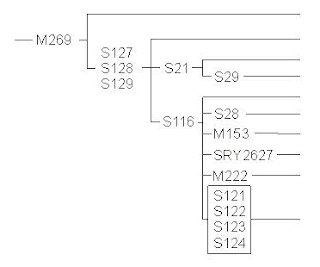I suppose in essence that is what I'm attempting to find. Maybe not a place, but a journey. I would like to plot and connect these people on a map through time. I'd like to be able to see my Thompsons and those proto-thompsons as they move across continents and over seas.
To begin with, lets look at the maps I first looked at after getting my DNA results. This is the map Ancestry.com gave me after my DNA test.
In general these two arrows do sort of sum it up. R1b seems to spring up in central Asia and move into western Europe. The general consensus at the time of this map was that R1b people hung around in the northern Basque region of Spain and then moved north after the last Glacial Maximum to inhabit Britain and Ireland.
After I found that I was R1b I wanted to know more about it than the generic Western European I was given and I found the percentage maps for R1b concentration:
So there is R1b. Of course the more red you get the better your odds of finding people like you. Generally it follows the simple arrows of the first map. Small amounts in Eastern Europe and Central Asia moving westward to higher amounts in Northern Spain, Western Britain and France with concentration peaking in Ireland.
At this point, it seemed safe to say that the Thompsons are basically Celts. R1b seems to follow the basic pattern of Celtic tribes in europe and is busy being tied to those same timelines through archeology and dna testing of artifacts.
I'd like to narrow that map down a bit though. Europe is a big place.
In the process of trying to find relatives any way possible I entered my results at Genetree which uses the Sorenson Database. They gave me a bit more of a prediction with this subgroup: R1b1b2a*-S128
It's still well above anything definitive but it's better than nothing. Having someone guess at my results led me to go look at other predictors, as you can read in my jumbled mess of analysis.
Two possible haplogroups came to the top depending on which panels I put in the mix: S21 and S28. The reason there are always several choices is because I have a subset of the panels that most people have. Here is what Ethnosancestry and ISOGG say about those groups:
Genetree says I'm S128 which is right off the main trunk for R1b-M269. It's the Parent of one of my haplogroup guesses S21 and the Grandparent of one of the other guesses S28 as well as our buddy m222 (Northwest Irish and Scottish borders). If I had real SNP testing and it came back that we were m222 then this conversation would be moot. M222 has been pretty well proven to live in the lowlands of Scotland and Northern Ireland. That's not what these guesses for me are though. So lets look at those guesses:
S21 (my haplogroup predictor came back s21-scottish). I've read some comment that it really should be labeled s116-scottish...which would actually be a parent of S28 (my other prediction). For the sake of argument though we'll accept S21 at face value and look at it's map.
The distribution of S21 is shown in orange, along with the rest of R1b in pale yellow.
S21 is most common in the Germanic areas of the North European plain and also in England. The frequency drops dramatically south of the Alps.
S28 appears to be fairly widespread moving out from Austria. I haven't found a good map of it yet but I hope to.
If that listing for S21 really is S116 then I may be no closer to finding some geographic locations. S116, like S28 appears to be widespread throughout the "Celtic" world and may defy mapping.
Next up. Let's take a look at YHRD and see what it comes up with. Along with my own maps and maybe we can make some coherent pattern out of this mess.





No comments:
Post a Comment